Maria Maistro
The Quest for Reliable Metrics of Responsible AI
Oct 29, 2025Abstract:The development of Artificial Intelligence (AI), including AI in Science (AIS), should be done following the principles of responsible AI. Progress in responsible AI is often quantified through evaluation metrics, yet there has been less work on assessing the robustness and reliability of the metrics themselves. We reflect on prior work that examines the robustness of fairness metrics for recommender systems as a type of AI application and summarise their key takeaways into a set of non-exhaustive guidelines for developing reliable metrics of responsible AI. Our guidelines apply to a broad spectrum of AI applications, including AIS.
Culinary Crossroads: A RAG Framework for Enhancing Diversity in Cross-Cultural Recipe Adaptation
Jul 29, 2025Abstract:In cross-cultural recipe adaptation, the goal is not only to ensure cultural appropriateness and retain the original dish's essence, but also to provide diverse options for various dietary needs and preferences. Retrieval Augmented Generation (RAG) is a promising approach, combining the retrieval of real recipes from the target cuisine for cultural adaptability with large language models (LLMs) for relevance. However, it remains unclear whether RAG can generate diverse adaptation results. Our analysis shows that RAG tends to overly rely on a limited portion of the context across generations, failing to produce diverse outputs even when provided with varied contextual inputs. This reveals a key limitation of RAG in creative tasks with multiple valid answers: it fails to leverage contextual diversity for generating varied responses. To address this issue, we propose CARRIAGE, a plug-and-play RAG framework for cross-cultural recipe adaptation that enhances diversity in both retrieval and context organization. To our knowledge, this is the first RAG framework that explicitly aims to generate highly diverse outputs to accommodate multiple user preferences. Our experiments show that CARRIAGE achieves Pareto efficiency in terms of diversity and quality of recipe adaptation compared to closed-book LLMs.
GIM: Improved Interpretability for Large Language Models
May 23, 2025Abstract:Ensuring faithful interpretability in large language models is imperative for trustworthy and reliable AI. A key obstacle is self-repair, a phenomenon where networks compensate for reduced signal in one component by amplifying others, masking the true importance of the ablated component. While prior work attributes self-repair to layer normalization and back-up components that compensate for ablated components, we identify a novel form occurring within the attention mechanism, where softmax redistribution conceals the influence of important attention scores. This leads traditional ablation and gradient-based methods to underestimate the significance of all components contributing to these attention scores. We introduce Gradient Interaction Modifications (GIM), a technique that accounts for self-repair during backpropagation. Extensive experiments across multiple large language models (Gemma 2B/9B, LLAMA 1B/3B/8B, Qwen 1.5B/3B) and diverse tasks demonstrate that GIM significantly improves faithfulness over existing circuit identification and feature attribution methods. Our work is a significant step toward better understanding the inner mechanisms of LLMs, which is crucial for improving them and ensuring their safety. Our code is available at https://github.com/JoakimEdin/gim.
As easy as PIE: understanding when pruning causes language models to disagree
Mar 27, 2025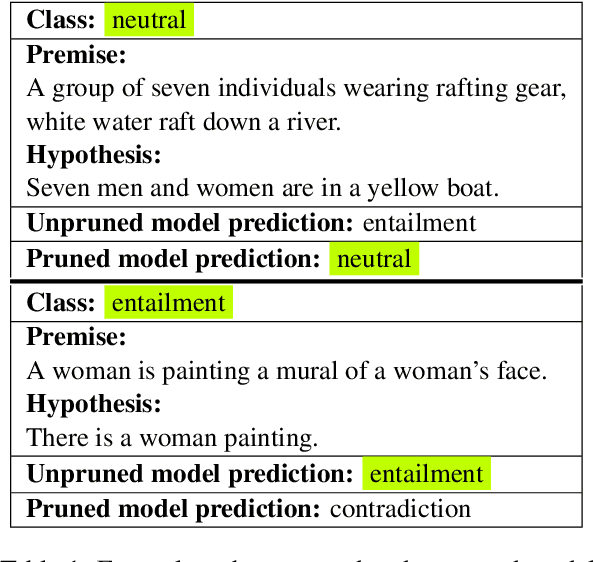
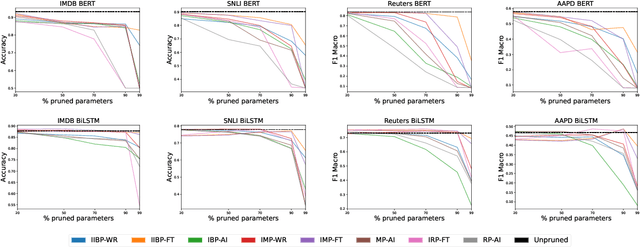


Abstract:Language Model (LM) pruning compresses the model by removing weights, nodes, or other parts of its architecture. Typically, pruning focuses on the resulting efficiency gains at the cost of effectiveness. However, when looking at how individual data points are affected by pruning, it turns out that a particular subset of data points always bears most of the brunt (in terms of reduced accuracy) when pruning, but this effect goes unnoticed when reporting the mean accuracy of all data points. These data points are called PIEs and have been studied in image processing, but not in NLP. In a study of various NLP datasets, pruning methods, and levels of compression, we find that PIEs impact inference quality considerably, regardless of class frequency, and that BERT is more prone to this than BiLSTM. We also find that PIEs contain a high amount of data points that have the largest influence on how well the model generalises to unseen data. This means that when pruning, with seemingly moderate loss to accuracy across all data points, we in fact hurt tremendously those data points that matter the most. We trace what makes PIEs both hard and impactful to inference to their overall longer and more semantically complex text. These findings are novel and contribute to understanding how LMs are affected by pruning. The code is available at: https://github.com/pietrotrope/AsEasyAsPIE
Joint Evaluation of Fairness and Relevance in Recommender Systems with Pareto Frontier
Feb 17, 2025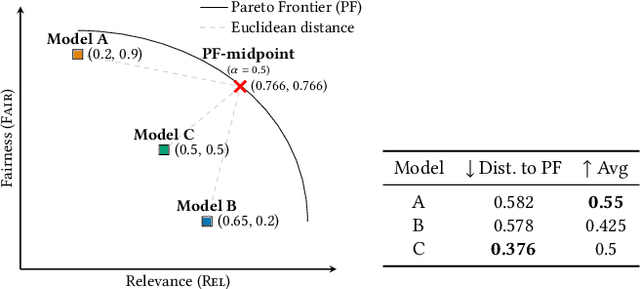

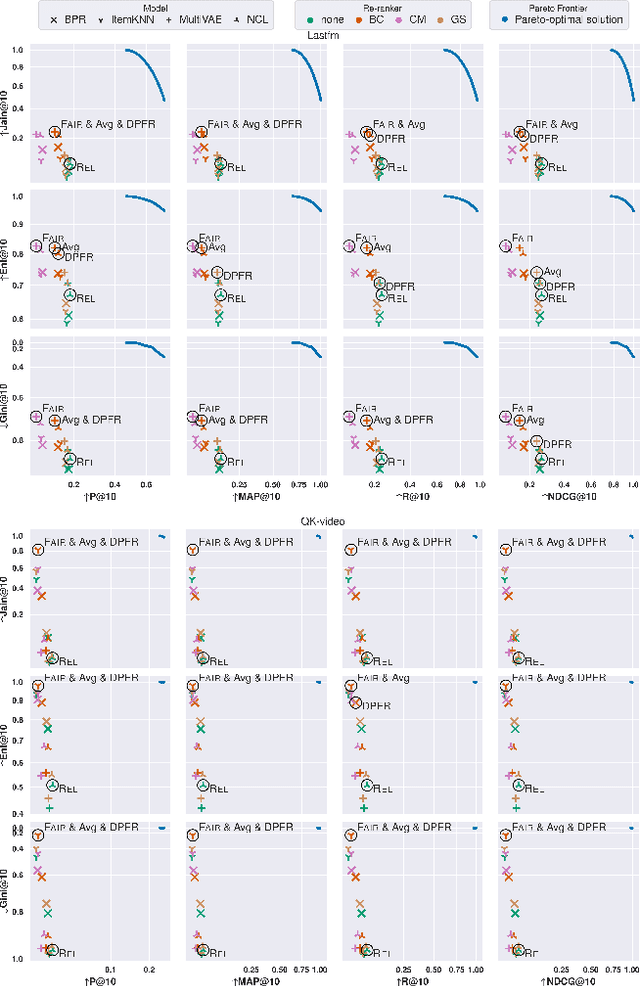
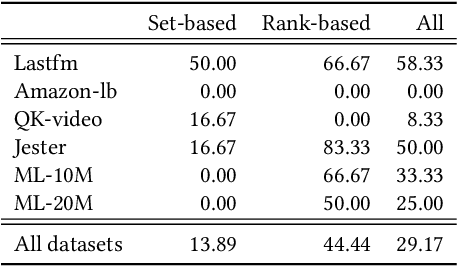
Abstract:Fairness and relevance are two important aspects of recommender systems (RSs). Typically, they are evaluated either (i) separately by individual measures of fairness and relevance, or (ii) jointly using a single measure that accounts for fairness with respect to relevance. However, approach (i) often does not provide a reliable joint estimate of the goodness of the models, as it has two different best models: one for fairness and another for relevance. Approach (ii) is also problematic because these measures tend to be ad-hoc and do not relate well to traditional relevance measures, like NDCG. Motivated by this, we present a new approach for jointly evaluating fairness and relevance in RSs: Distance to Pareto Frontier (DPFR). Given some user-item interaction data, we compute their Pareto frontier for a pair of existing relevance and fairness measures, and then use the distance from the frontier as a measure of the jointly achievable fairness and relevance. Our approach is modular and intuitive as it can be computed with existing measures. Experiments with 4 RS models, 3 re-ranking strategies, and 6 datasets show that existing metrics have inconsistent associations with our Pareto-optimal solution, making DPFR a more robust and theoretically well-founded joint measure for assessing fairness and relevance. Our code: https://github.com/theresiavr/DPFR-recsys-evaluation
Are Representation Disentanglement and Interpretability Linked in Recommendation Models? A Critical Review and Reproducibility Study
Jan 30, 2025



Abstract:Unsupervised learning of disentangled representations has been closely tied to enhancing the representation intepretability of Recommender Systems (RSs). This has been achieved by making the representation of individual features more distinctly separated, so that it is easier to attribute the contribution of features to the model's predictions. However, such advantages in interpretability and feature attribution have mainly been explored qualitatively. Moreover, the effect of disentanglement on the model's recommendation performance has been largely overlooked. In this work, we reproduce the recommendation performance, representation disentanglement and representation interpretability of five well-known recommendation models on four RS datasets. We quantify disentanglement and investigate the link of disentanglement with recommendation effectiveness and representation interpretability. While several existing work in RSs have proposed disentangled representations as a gateway to improved effectiveness and interpretability, our findings show that disentanglement is not necessarily related to effectiveness but is closely related to representation interpretability. Our code and results are publicly available at https://github.com/edervishaj/disentanglement-interpretability-recsys.
A Reality Check on Context Utilisation for Retrieval-Augmented Generation
Dec 22, 2024



Abstract:Retrieval-augmented generation (RAG) helps address the limitations of the parametric knowledge embedded within a language model (LM). However, investigations of how LMs utilise retrieved information of varying complexity in real-world scenarios have been limited to synthetic contexts. We introduce DRUID (Dataset of Retrieved Unreliable, Insufficient and Difficult-to-understand contexts) with real-world queries and contexts manually annotated for stance. The dataset is based on the prototypical task of automated claim verification, for which automated retrieval of real-world evidence is crucial. We compare DRUID to synthetic datasets (CounterFact, ConflictQA) and find that artificial datasets often fail to represent the complex and diverse real-world context settings. We show that synthetic datasets exaggerate context characteristics rare in real retrieved data, which leads to inflated context utilisation results, as measured by our novel ACU score. Moreover, while previous work has mainly focused on singleton context characteristics to explain context utilisation, correlations between singleton context properties and ACU on DRUID are surprisingly small compared to other properties related to context source. Overall, our work underscores the need for real-world aligned context utilisation studies to represent and improve performance in real-world RAG settings.
Normalized AOPC: Fixing Misleading Faithfulness Metrics for Feature Attribution Explainability
Aug 15, 2024



Abstract:Deep neural network predictions are notoriously difficult to interpret. Feature attribution methods aim to explain these predictions by identifying the contribution of each input feature. Faithfulness, often evaluated using the area over the perturbation curve (AOPC), reflects feature attributions' accuracy in describing the internal mechanisms of deep neural networks. However, many studies rely on AOPC to compare faithfulness across different models, which we show can lead to false conclusions about models' faithfulness. Specifically, we find that AOPC is sensitive to variations in the model, resulting in unreliable cross-model comparisons. Moreover, AOPC scores are difficult to interpret in isolation without knowing the model-specific lower and upper limits. To address these issues, we propose a normalization approach, Normalized AOPC (NAOPC), enabling consistent cross-model evaluations and more meaningful interpretation of individual scores. Our experiments demonstrate that this normalization can radically change AOPC results, questioning the conclusions of earlier studies and offering a more robust framework for assessing feature attribution faithfulness.
From Internal Conflict to Contextual Adaptation of Language Models
Jul 24, 2024



Abstract:Knowledge-intensive language understanding tasks require Language Models (LMs) to integrate relevant context, mitigating their inherent weaknesses, such as incomplete or outdated knowledge. Nevertheless, studies indicate that LMs often ignore the provided context as it can conflict with the pre-existing LM's memory learned during pre-training. Moreover, conflicting knowledge can already be present in the LM's parameters, termed intra-memory conflict. Existing works have studied the two types of knowledge conflicts only in isolation. We conjecture that the (degree of) intra-memory conflicts can in turn affect LM's handling of context-memory conflicts. To study this, we introduce the DYNAMICQA dataset, which includes facts with a temporal dynamic nature where a fact can change with a varying time frequency and disputable dynamic facts, which can change depending on the viewpoint. DYNAMICQA is the first to include real-world knowledge conflicts and provide context to study the link between the different types of knowledge conflicts. With the proposed dataset, we assess the use of uncertainty for measuring the intra-memory conflict and introduce a novel Coherent Persuasion (CP) score to evaluate the context's ability to sway LM's semantic output. Our extensive experiments reveal that static facts, which are unlikely to change, are more easily updated with additional context, relative to temporal and disputable facts.
An Unsupervised Approach to Achieve Supervised-Level Explainability in Healthcare Records
Jun 13, 2024Abstract:Electronic healthcare records are vital for patient safety as they document conditions, plans, and procedures in both free text and medical codes. Language models have significantly enhanced the processing of such records, streamlining workflows and reducing manual data entry, thereby saving healthcare providers significant resources. However, the black-box nature of these models often leaves healthcare professionals hesitant to trust them. State-of-the-art explainability methods increase model transparency but rely on human-annotated evidence spans, which are costly. In this study, we propose an approach to produce plausible and faithful explanations without needing such annotations. We demonstrate on the automated medical coding task that adversarial robustness training improves explanation plausibility and introduce AttInGrad, a new explanation method superior to previous ones. By combining both contributions in a fully unsupervised setup, we produce explanations of comparable quality, or better, to that of a supervised approach. We release our code and model weights.
 Add to Chrome
Add to Chrome Add to Firefox
Add to Firefox Add to Edge
Add to Edge